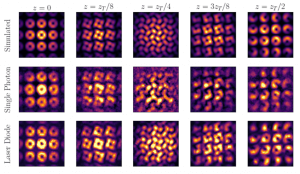Summary
Arrays of orbital angular momentum (OAM) states of light are a new form of structured light so far relatively unexplored in quantum information science. Unlike spin angular momentum of light, which is related to light’s polarization and covers two dimensions, OAM states, sometimes described as ‘donut beams’ due to the shape of the field intensity distribution in their cross section, are in principle an infinite dimensional system and can be used to carry much more information per photon. In this project, we generate arrays of entangled orbital angular momentum beams and explore the utility of the spatially entangled photons in quantum communication protocols, such as remote state preparation. In collaboration with Dmitry Pushin, David Cory, and Thomas Jennewein, we study the propagation of entangled OAM arrays and their self-imaging capabilities known as the Talbot Effect, which hold promise for developing a new method to measure OAM. As we learn to control the spatial patterns of these light beams we expect they may find application in sensing of periodic optical structures in materials.

Figure 1. Simulated and observed intensity distribution in orbital angular momentum arrays as they propagate over different fractional Talbot lengths
Related Content

On-Chip Microwave-Optical Quantum Interface
Summary In this project we develop a quantum interface between microwave and optical photons as a key enabling technology of a hybrid quantum network. In such a network, the robust optical photons carry quantum information through optical fibres over long distances, while superconducting microwave circuits protected from thermal photon noise by the low temperature […]
October 29, 2018
Using Interactive Digital Storytelling to Represent Transformative Quantum Technologies in Augmented/Extended Reality Environments
Summary A major roadblock to the broader adoption of quantum technologies is the long learning curve associated with their seemingly abstract concepts. This often renders quantum technologies inaccessible to most audiences, especially through explanations using conventional scientific language. In this project, we develop novel methods of interactive digital storytelling – augmented and extended reality (AR/XR) […]
February 24, 2021

Applications of Neutron Interferometry and Structured Neutron Beams
Summary Neutrons are a powerful probe of matter and physics due to their Angstrom size wavelengths, electric neutrality and relatively large mass. In this project, we develop quantum sensors that exploit these attributes to increases the precision of measurements of fundamental forces and materials structure. With David Cory, Alexander Cronin of the University of Arizona, […]
July 31, 2018
Line-Scanning optical coherence tomography system for in-vivo, non-invasive imaging of the cellular structure and blood perfusion of biological tissue
Summary Optical coherence tomography (OCT) is an optical imaging method that allows for in-vivo, non-invasive imaging of the structure and vasculature of biological tissue. Commercially available, clinical OCT systems utilize point-scanning method to acquire volumetric images over a large surface with typical frame rates of ~ 30 frames/ second. Since living biological tissue is constantly […]
August 27, 2019

